
Turtles are reptiles belonging to the order Testudines, which is one of four reptilian orders, the others being crocodilians, squamates (lizards and snakes) and rhynchocephalians (tuatara).
On this page we take a look at 30 notable types of turtles, from the land-dwelling desert tortoise Gopherus agassizii, to the mighty leatherback sea turtle Dermochelys coriacea, the world’s largest living turtle.
How Many Different Types Of Turtles Are There?
There are 356 turtle species (including tortoises). Together, turtles account for just 3% of all reptiles; there are around 10 times as many snake species, and 20 times as many lizard species, than there are species of turtle.
There are two main types of turtles: “side-necked turtles” of suborder Pleurodira; and “hidden-neck turtles” of suborder Cryptodira; just over two thirds of turtles are hidden-neck turtles. Well-known types of turtles include tortoises, which are land-living turtles of family Testudinidae; terrapins, which are generally small, aquatic turtles; and sea turtles, which are seven species of large, marine turtles.
- Hidden-neck turtles (suborder Cryptodira) are able to pull their heads straight back into their shells.
- Side-necked turtles (suborder Pleurodira) have to move their necks sideways in order to protect their heads in their shells.
Below is a list of turtle species from all around the world. We’ve included turtles commonly kept as pets; two of the seven species of sea turtle (you can see the others on this page: Sea Turtles); North American turtles such as the box, musk and snapping turtles, and interesting turtle species from other parts of the world…
Types Of Turtles Index
- African Helmeted Turtle
- Alabama Red-Bellied Cooter
- Alligator Snapping Turtle
- Arrau Turtle / Giant River Turtle
- Asian Giant Softshell Turtle
- Big-Headed Turtle
- Common Box Turtle
- Common Musk Turtle
- Common Snapping Turtle
- Desert Tortoise
- Diamondback Terrapin
- East African Black Mud Turtle
- Eastern Long-Necked Turtle
- False Map Turtle
- Florida Softshell Turtle
- Four-Eyed Turtle
- Green Sea Turtle
- Hickatee
- Leatherback Sea Turtle
- Malaysian Giant Turtle
- Western Box Turtle / Ornate Box Turtle
- Painted Turtle
- Pig-Nosed Turtle
- Pond Slider
- Roti Island Snake-Necked Turtle
- Spiny Softshell Turtle
- Spotted Turtle
- Striped Mud Turtle
- Western Swamp Turtle
Related Pages
- Reptiles: The Ultimate Guide
- Types Of Lizards
- Types Of Reptiles
- Is A Turtle A Reptile? And Why?
- Reptile Books
African Helmeted Turtle

- Scientific name: Pelomedusa subrufa
- Suborder: Pleurodira (side-necked turtles)
- Family: Pelomedusidae
- Where found: Africa (including Madagascar), Asia
- Conservation status: Unassessed
The African helmeted turtle is a small, side-necked turtle found throughout sub-Saharan Africa, and in Yemen in western Asia.
Also known as “crocodile turtle” and “marsh terrapin”, this semi-aquatic species can be found in both permanent and temporary bodies of water, but shows a preference for standing water such as lakes, swamps and rain puddles over rivers.
The African helmeted turtle shares its habitat with iconic African animals such as crocodiles, warthogs, hippopotamuses, buffalos and rhinos. In recent years, it has been documented that some of these larger mammals benefit from the turtle eating parasites from their bodies.
Unlike other members of the family Pelomedusidae, the African helmeted turtle does not possess a hinged plastron, and is therefore unable to encase its head and front limbs in its shell by closing its plastron.
Discover More with Active Wild
You can see more African reptiles on this page: African Reptiles List with Pictures & Facts
Alabama Red-Bellied Cooter
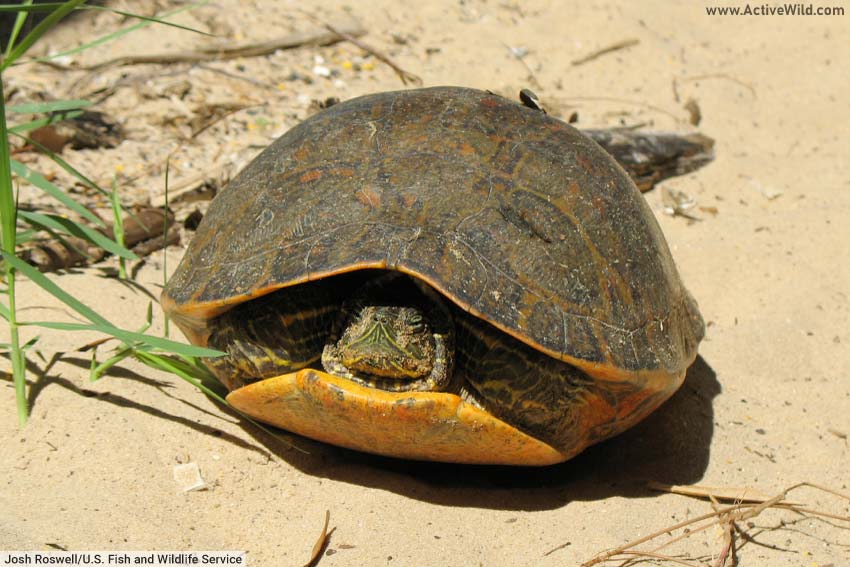
- Scientific name: Pseudemys alabamensis
- Suborder: Cryptodira (hidden-neck turtles)
- Family: Emydidae
- Where found: North America
- Conservation status: Endangered
The Alabama red-bellied cooter is a member of the pond turtle family, Emydidae. It is found only in Alabama, USA, and is the official reptile of that state.
The species is named after the orange-red color of its plastron. Females are slightly bigger than males, having a maximum length of around 35.5 cm / 14 in, compared to the males’ 30 cm / 12 in.
The Alabama red-bellied cooter inhabits dense vegetation in freshwater and brackish waters of the Mobile-Tensaw River Delta.
Discover More with Active Wild
You can see more North American reptiles on this page: North American Reptiles List with Pictures & Facts
Alligator Snapping Turtle
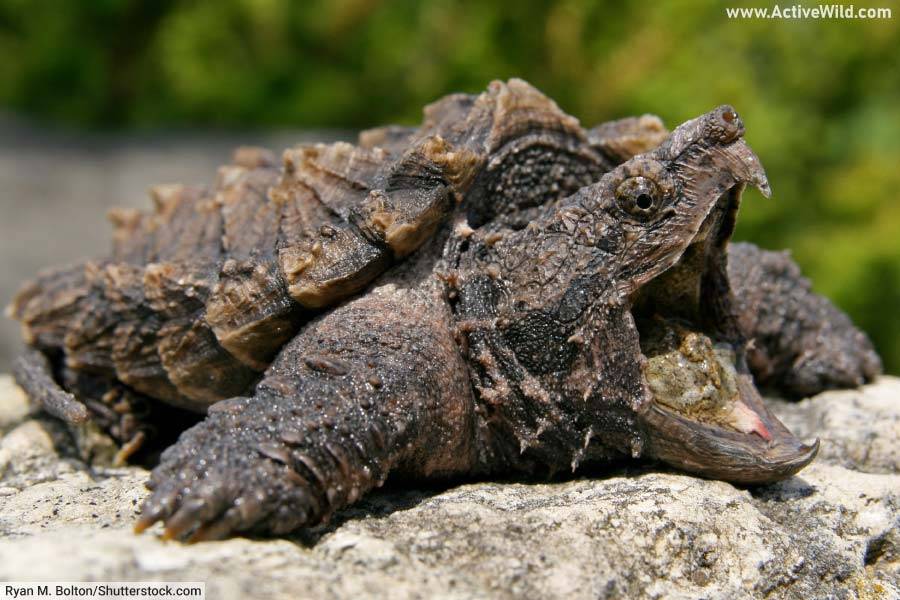
- Scientific name: Macrochelys temminckii
- Suborder: Cryptodira (hidden-neck turtles)
- Family: Chelydridae
- Where found: North America
- Conservation status: Vulnerable
The alligator snapping turtle reaches weights of over 100 kg / 220 lb., and has a carapace length of over 80 cm / 2.62 ft., making it one of the world’s largest freshwater turtle species. Only the Asian softshell species of family Trionychidae reach similar (or larger) sizes.
Named for the resemblance of its heavily-ridged shell to the skin of an alligator, the alligator snapping turtle is found in the southeastern United States. It inhabits rivers that flow into the Gulf of Mexico.
The alligator snapping turtle has an unusual way of feeding. The tip of its tongue resembles a worm, and by sitting motionless on the riverbed with its mouth open, the turtle lures fish – attracted by the “worm” – to within snapping range of its powerful jaws.
The turtle will also eat a wide variety of other prey, including birds, snakes, mammals and even other turtles. Its powerful jaws are quite capable of severing a human finger.
Discover More with Active Wild
You can find out more about the alligator snapping turtle on this page: Alligator Snapping Turtle Facts
You can see more North American reptiles on this page: North American Reptiles List with Pictures & Facts
Arrau Turtle / Giant River Turtle
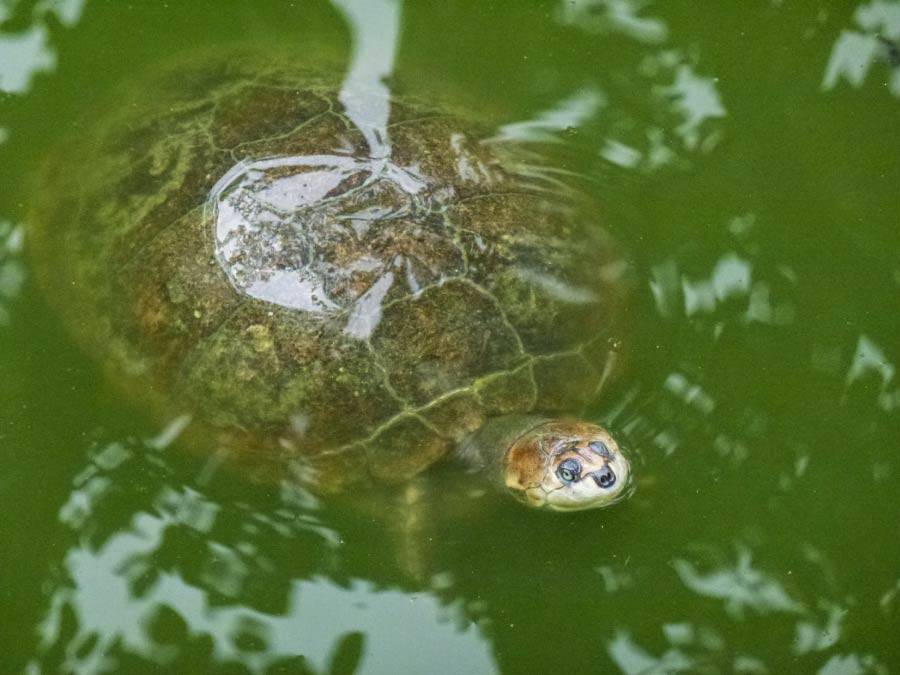
- Scientific name: Podocnemis expansa
- Suborder: Pleurodira (side-necked turtles)
- Family: Podocnemididae
- Where found: South America
- Conservation status: Lower Risk / Conservation Dependent
The Arrau turtle is both the largest side-neck turtle, and the largest non-marine turtle, found in South and Central America. It is a member of the family Podocnemididae.
Individuals of this species normally reach a carapace length of 90 cm / 35 in. and a weight of 60 kg / 130 lbs., although cases of Arrau turtles reaching 100 kg / 220 lbs. have occurred.
While primarily herbivorous, the giant river turtle is an opportunistic feeder that will eat carrion and smaller animals when it has the chance to do so.
The Arrau turtle was once a common sight along the banks of the Amazon and Orinoco rivers, but in recent times its population has decreased dramatically. It is heavily hunted by locals for its meat and eggs, even in areas where this practice has been deemed illegal.
Discover More with Active Wild
Discover more rainforest reptiles on this page: Rainforest Reptiles List with Pictures & Facts
Asian Giant Softshell Turtle
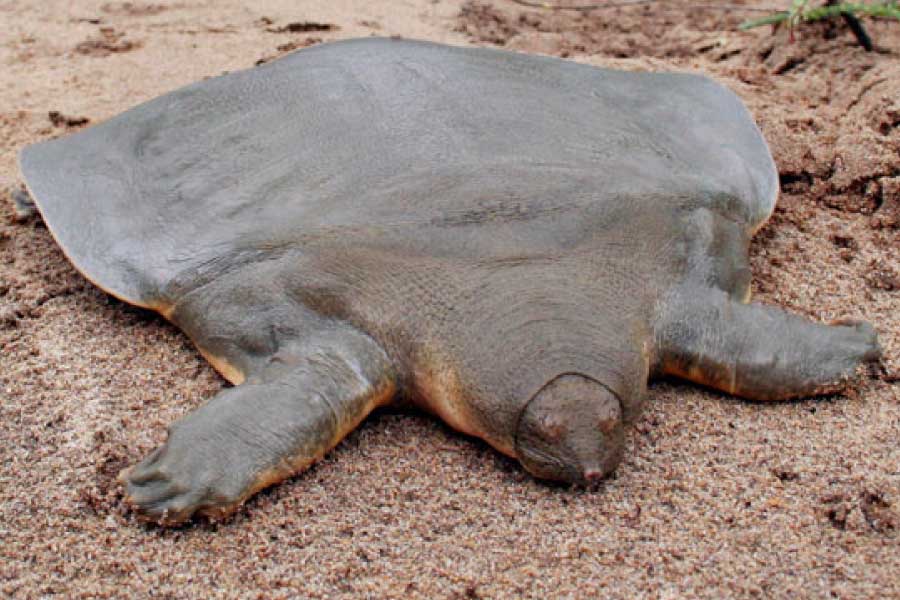
- Scientific name: Pelochelys cantorii
- Suborder: Cryptodira (hidden-neck turtles)
- Family: Trionychidae
- Where found: Southeast Asia
- Conservation status: Critically Endangered
The Asian giant softshell turtle is a member of the “softshell turtle” family, Trionychidae. Like other members of this family, it has a flat carapace that lacks scutes (bony plates), giving a smooth, leathery and comparatively “soft” feel. Adults are mostly olive green, while juveniles tend to have some dark spots on their shells and faces.
With a carapace that reaches lengths of up to 1 m / 3.28 ft, the Asian giant softshell turtle is the largest member of its family. Females are significantly larger than males.
Unproven reports of individuals with carapace lengths of up to 1.8 m / 5.9 ft. would make the species the largest freshwater turtle; as things stand, it shares this title with several other members of its family.
The Asian giant softshell will occasionally eat aquatic plants but is are mainly carnivorous. It is an ambush hunter, relying on a fast, outward head movement paired with a simultaneous and powerful bite to capture its prey.
The species’ population is rapidly decreasing, mainly due to habitat destruction and human consumption of individuals and eggs.
Discover More with Active Wild
You can see more Asian animals on this page: Asian Animals: Pictures & Facts
Big-Headed Turtle
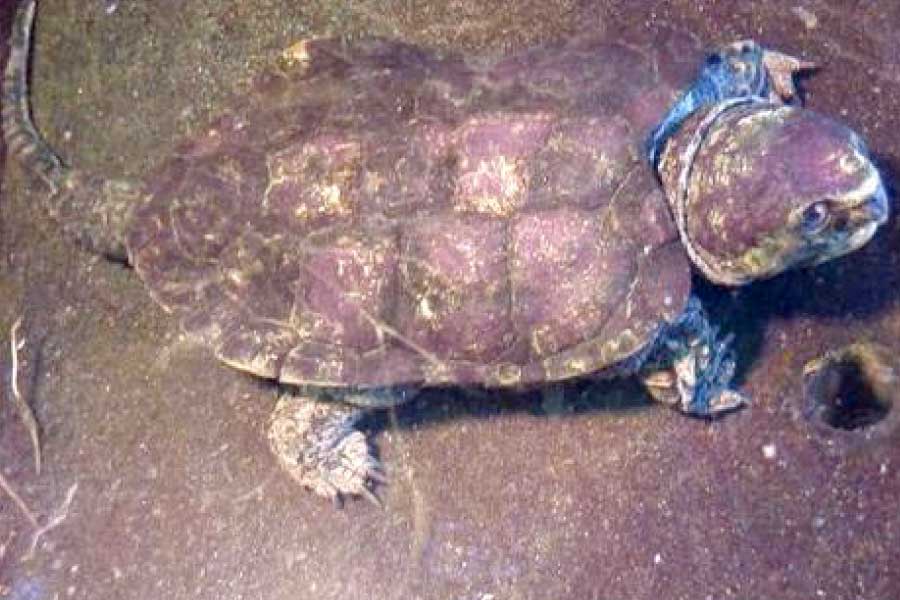
- Scientific name: Platysternon megacephalum
- Suborder: Cryptodira (hidden-neck turtles)
- Family: Platysternidae
- Where found: Southeast Asia
- Conservation status: Critically Endangered
The big-headed turtle is a hidden-neck turtle found in east and southeast Asia.
As its name suggests, the big-headed turtle has a disproportionately large head. Its head, and long tail together make up for half of its average body length of 40 cm / 16 inches.
The turtle’s muscular, long tail is able to hold the entire weight of the turtle, and is used to help the turtle climb over obstacles.
Although the big-headed turtle’s head can’t retract into the shell, it has an extremely strong skull to make up for the lack of protection.
Very little is known about the big-headed turtle’s reproductive habits besides the fact that it lays just 1 – 2 eggs per clutch.
This, combined with threats such as an ever-growing demand from the illegal pet trade and habitat loss throughout its range, have caused the species to become Critically Endangered.
Discover More with Active Wild
You can see more Asian animals on this page: Asian Animals: Pictures & Facts
Common Box Turtle
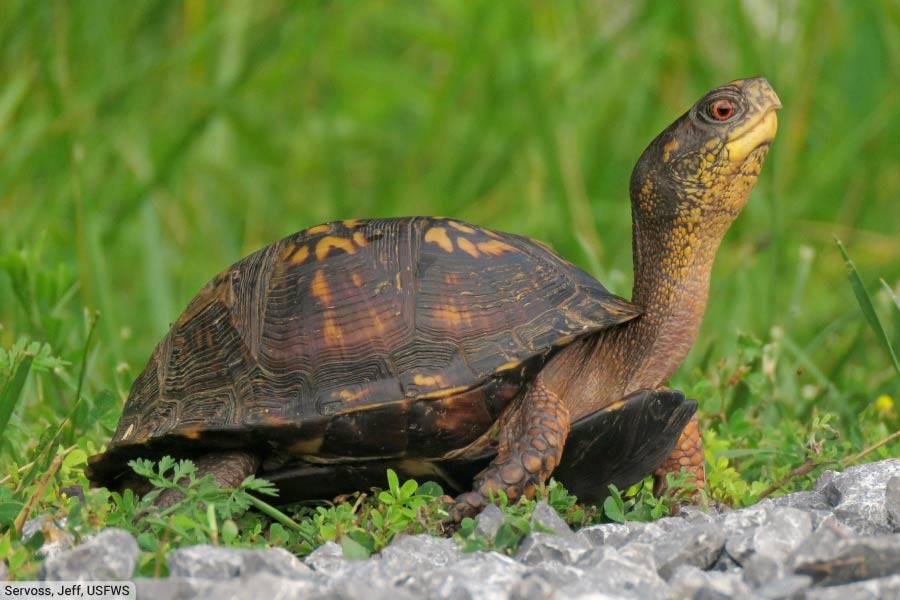
- Scientific name: Terrapene carolina
- Suborder: Cryptodira (hidden-neck turtles)
- Family: Emydidae
- Where found: North America
- Conservation status: Vulnerable
The common box turtle is one of six or seven species of box turtle, which together make up the genus Terrapene. It is also known as the “eastern box turtle”.
(There is some debate over the exact number of box turtle species, as the Yucatán box turtle is considered by some to be a subspecies of the common box turtle, rather than a separate species.)
The plastron of a Box turtle is hinged, allowing the turtle to close up its shell to protect itself from predators.
Found in southern Canada, the eastern United States and northern Mexico, the common box turtle is, like all box turtles, primarily terrestrial (land-dwelling). It inhabits forests, shrublands and inland wetlands.
The common box turtle has seven subspecies, including the eastern box turtle, Florida box turtle and Mexican box turtle.
Discover More with Active Wild
You can see more North American reptiles on this page: North American Reptiles List with Pictures & Facts
Common Musk Turtle
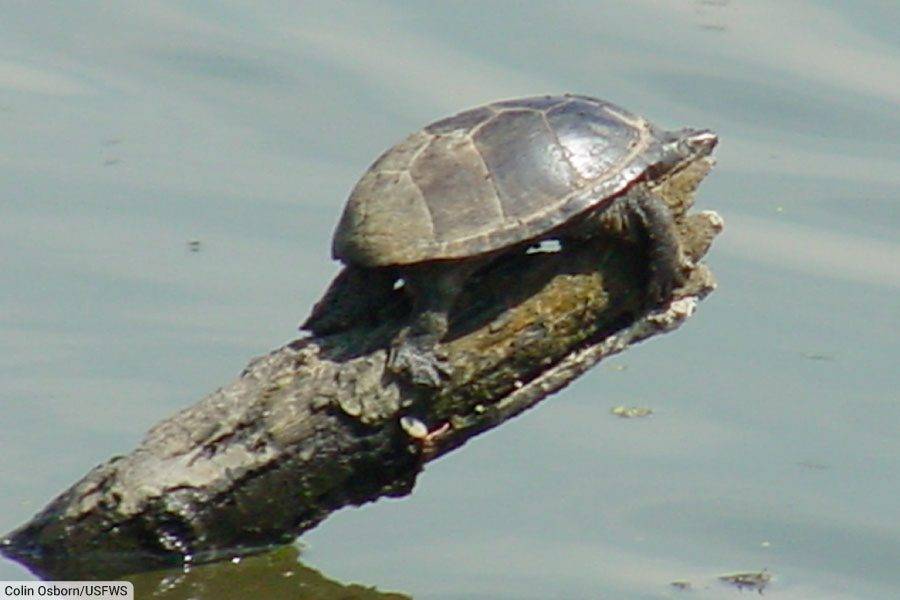
- Scientific name: Sternotherus odoratus
- Suborder: Cryptodira (hidden-neck turtles)
- Family: Kinosternidae
- Where found: North America
- Conservation status: Least Concern
The common musk turtle is also known as the “stinkpot”, due to its ability to secrete a foul-smelling yellowish fluid from scent glands located on its undersides.
The small turtle’s shell is between 7.5 and 14 cm / 3 and 5.5 inches in length, and is smooth and high-domed. Two yellow stripes run along either side of the head.
The common musk turtle is found in southeastern Canada, and throughout most of the eastern United States. It inhabits both flowing and still freshwater environments, and spends less time basking than similar species. Its diet consists mainly of mollusks.
Discover More with Active Wild
You can see more North American reptiles on this page: North American Reptiles List with Pictures & Facts
Common Snapping Turtle
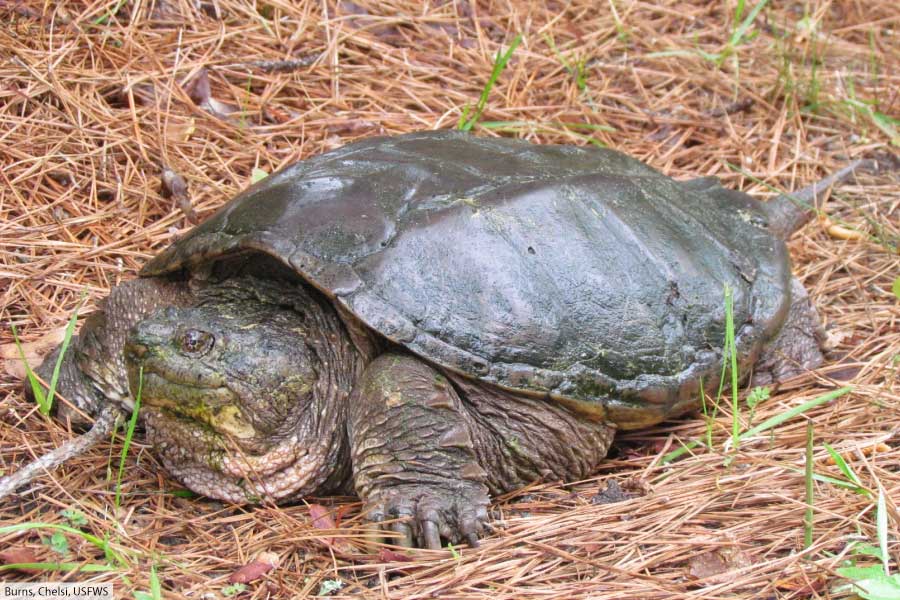
- Scientific name: Chelydra serpentina
- Suborder: Cryptodira (hidden-neck turtles)
- Family: Chelydridae
- Where found: North America (introduced: parts of Asia)
- Conservation status: Least Concern
Due to its perceived aggression and the fabled power of its jaws, the common snapping turtle is one of America’s best known turtle species. It is the most widespread of the three snapping turtle species, and the only one found in the United States and Canada.
Snapping turtle eggs and hatchlings have many predators, but once the species reaches a certain size it is relatively safe from predation. Only bears, alligators, and with less frequency, river otters, have been documented preying on adult snappers.
The common snapping turtle is solitary and extremely aggressive. It has been known to kill other turtles by decapitating them with its powerful jaws, a behavior that has been attributed to territoriality.
An omnivore, the common snapping turtle eats large amounts of aquatic plants, as well as foraging for carrion and actively hunting numerous animals, including waterfowl and small mammals. It usually employs an ambush strategy, waiting for its prey to draw near before launching an attack.
The common snapping turtle has a maximum carapace length of 50 cm / 19 inches and a maximum weight of 35 kg / 77 lb., although the average specimen is significantly smaller. The species’ tail is almost as long as its shell.
Discover More with Active Wild
You can see more North American reptiles on this page: North American Reptiles List with Pictures & Facts
Desert Tortoise
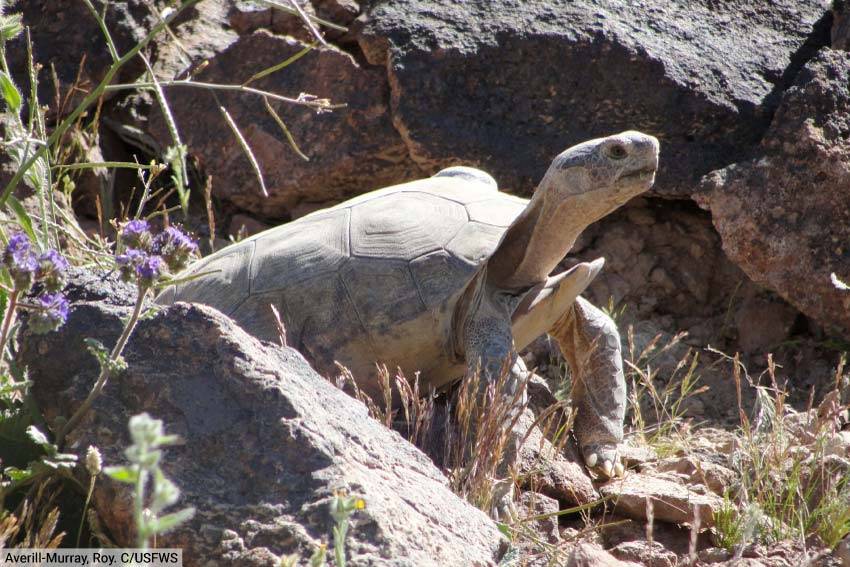
- Scientific name: Gopherus agassizii
- Suborder: Cryptodira (hidden-neck turtles)
- Family: Testudinidae
- Where found: Southwestern United States
- Conservation status: Critically Endangered
Also known as “Mojave desert tortoise” and “California desert tortoise”, the desert tortoise is endemic to (only found in) the United States. It inhabits dry shrublands in California, Nevada, Utah and Arizona.
Females lay 1 clutch per year, each of which may contain between 1 and 14 eggs (the average is 3 to 5 eggs.) The yolk provides the infant with enough nutrients not only for its development inside the egg, but also for up to 6 months after hatching.
Desert tortoises are herbivorous. They spend 95 – 98 % of their life underground. They are equipped with long claws that make them efficient diggers.
Males tend to be larger than females, reaching a weight of 20 kg / 44 lbs. Females are around 13 kg / 28 lbs. in weight. Both sexes have a shell length of 25. 4 to 40 cm / 10 to 15.7 in.
The main threats to this critically endangered species are habitat loss and habitat fragmentation, both caused by to human activity.
Discover More with Active Wild
Discover more about the desert tortoise on this page: Desert Tortoise Facts
You can see more North American reptiles on this page: North American Reptiles List with Pictures & Facts
You can see more desert animals on this page: Desert Animals – Pictures & Facts
Diamondback Terrapin / Terrapin
![Ryan Hagerty [Public domain], via Wikimedia Commons](https://environment.org/wp-content/uploads/2022/06/Diamondback-Terrapin.jpg)
- Scientific name: Malaclemys terrapin
- Suborder: Cryptodira (hidden-neck turtles)
- Family: Emydidae
- Where found: Eastern United States
- Conservation status: Vulnerable
The diamondback terrapin is found near the coast in the eastern and southern United States. It is rare among reptiles in that it inhabits brackish waters (waters in which freshwater is mixed with seawater), such as estuaries, creeks, swamps and marshes. It must, however, remain close to freshwater to avoid dehydration.
As with sea turtles, the female terrapin finds a nesting site on beaches above the high tide line. Here, it lays anywhere from 4 – 18 eggs (with some studies suggesting as many as 25) between the months of April through July. Incubation takes 80 – 90 days.
One of the major threats to the diamondback terrapin throughout most of its range is accidental capture in crab pots intended for the blue crab, an edible crustacean. The terrapins enter the crab pots, and, unable to escape, eventually drown.
Other contributing causes to the diamondback terrapin’s decline include a loss of nesting sites due to agricultural and residential development, and being hit by both cars and boats.
Discover More with Active Wild
You can see more North American reptiles on this page: North American Reptiles List with Pictures & Facts
East African Black Mud Turtle
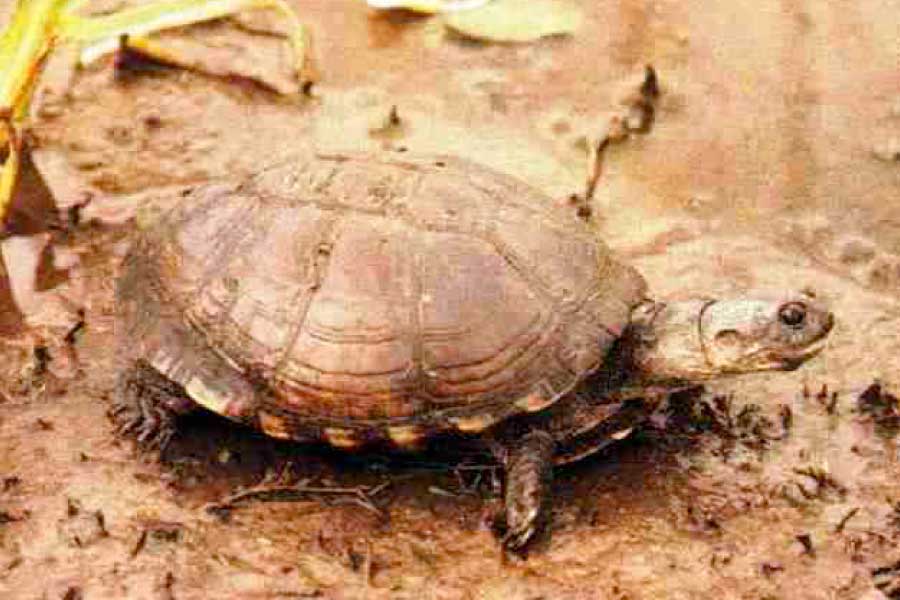
- Scientific name: Pelusios subniger
- Suborder: Pleurodira (side-necked turtles)
- Family: Pelomedusidae
- Where found: Africa
- Conservation status: Least Concern
The East African black mud turtle is an African species also known as the Pan terrapin and the black-bellied hinged terrapin. It is found in tropical and sub-tropical regions of eastern and southeastern Africa.
The species’ carapace is 13 to 20 cm / 5.1 to 7.9 inches in length, and is mostly smooth with yellow markings on its edges.
An omnivore, the East African black mud turtle will eat fish, invertebrates and plants. It is mostly active at night.
This species can be kept as a pet, but although easily handled, will act aggressively towards other turtles.
Discover More with Active Wild
You can see more African reptiles on this page: African Reptiles List with Pictures & Facts
Eastern Long-Necked Turtle

- Scientific name: Chelodina longicollis
- Suborder: Pleurodira (side-necked turtles)
- Family: Chelidae
- Where found: Australia
- Conservation status: Unassessed
Named after its exceptionally long neck, this freshwater turtle is found in southeastern Australia. The head and neck, when extended, make up 60% of the turtle’s total length of 25 cm / 9.84 in.
The eastern long-necked turtle has a lifespan of up to 37 years. A carnivore, the turtle’s prey consists of fish, mollusks, crustaceans, tadpoles and other aquatic invertebrates. They will also occasionally catch terrestrial insects.
The species has a peculiar defense mechanism: when threatened by a predator, it will emit a foul smelling yellow fluid from its musk glands. It is also known to retract its head into its shell and charge a potential predator, sometimes while also snapping its jaws defensively.
Discover More with Active Wild
You can see more Australian reptiles on this page: Australian Reptiles List with Pictures & Facts
False Map Turtle
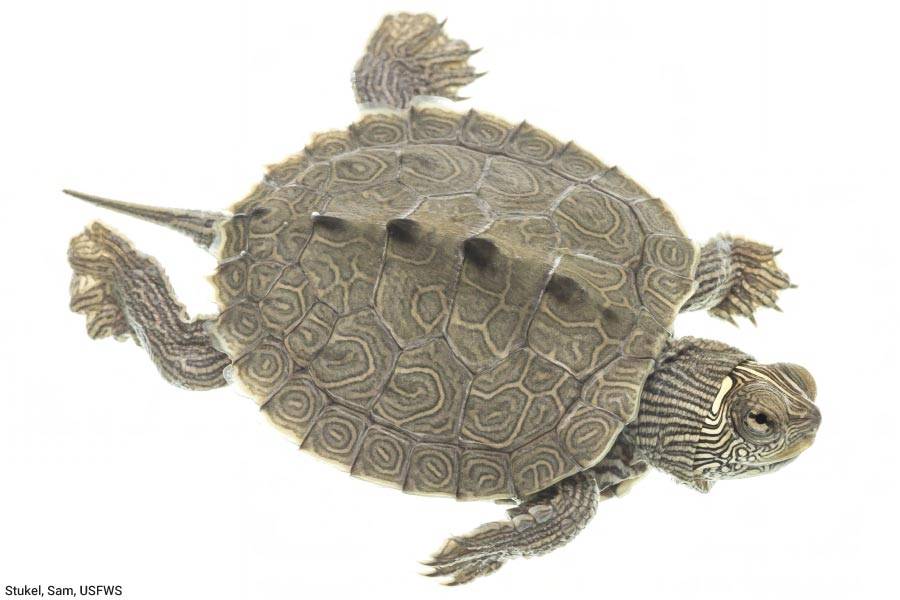
- Scientific name: Graptemys pseudogeographica
- Suborder: Cryptodira (hidden-neck turtles)
- Family: Emydidae
- Where found: United States
- Conservation status: Least Concern
The false map turtle is one of 14 species of map turtle, so-named due to the map-like markings on their shells. The false map turtle is found in large streams in the Mississippi-Missouri basin. The species is also known as the “Mississippi map turtle”.
The female has a carapace length of 20 – 27 cm / 7.9 – 10.6 in., making it around twice as long as the male, which reaches lengths of 9 – 14 cm / 3.5 – 5.5 in.
Like most turtle and tortoise species, the false map turtle has temperature dependent sex determination, with cooler nests resulting in all-male clutches, and warmer nests resulting in all-female clutches.
Discover More with Active Wild
You can see more North American reptiles on this page: North American Reptiles List with Pictures & Facts
Florida Softshell Turtle
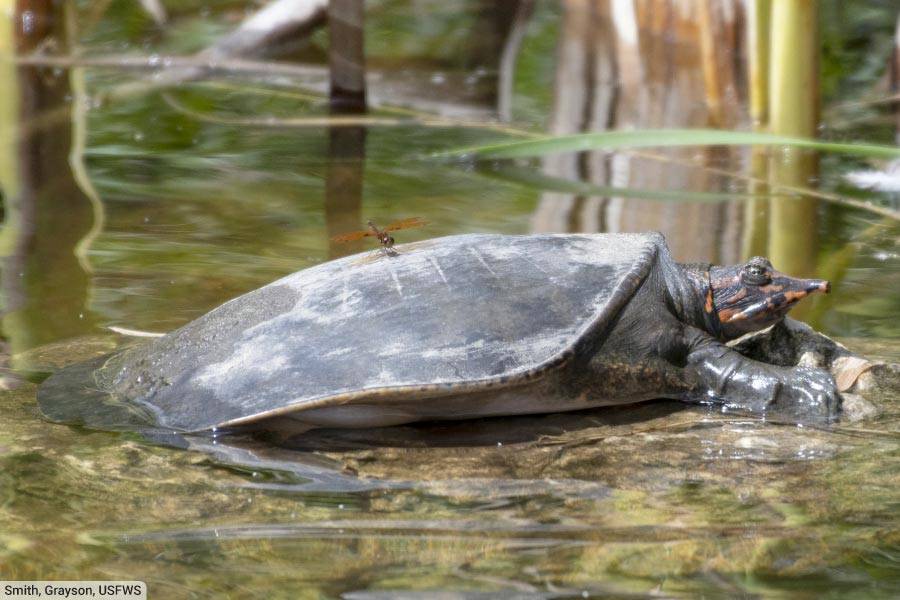
- Scientific name: Apalone ferox
- Suborder: Cryptodira (hidden-neck turtles)
- Family: Trionychidae
- Where found: North America
- Conservation status: Least Concern
The Florida softshell turtle is the largest member of the softshell turtle family, Trionychidae, found in the Americas.
Endemic to (only found in) the United States, the species inhabits slow-moving and still bodies of freshwater in Florida, Georgia, South Carolina and Alabama.
Unlike most other turtle and tortoise species, the sex of the hatchlings is completely genetic and not affected at all by nest temperature.
The color of individuals ranges from dark olive green to brown. It is the darkest softshell turtle present in Florida. The plastron is usually white.
Like all softshell turtles, the Florida softshell turtle’s shell lacks hard, bony scutes, and is soft and leathery to the touch.
Sexual dimorphism occurs in this species with females being up to four times larger than the males. Larger females are attributed with larger clutch sizes.
Discover More with Active Wild
You can see more North American reptiles on this page: North American Reptiles List with Pictures & Facts
Four-Eyed Turtle
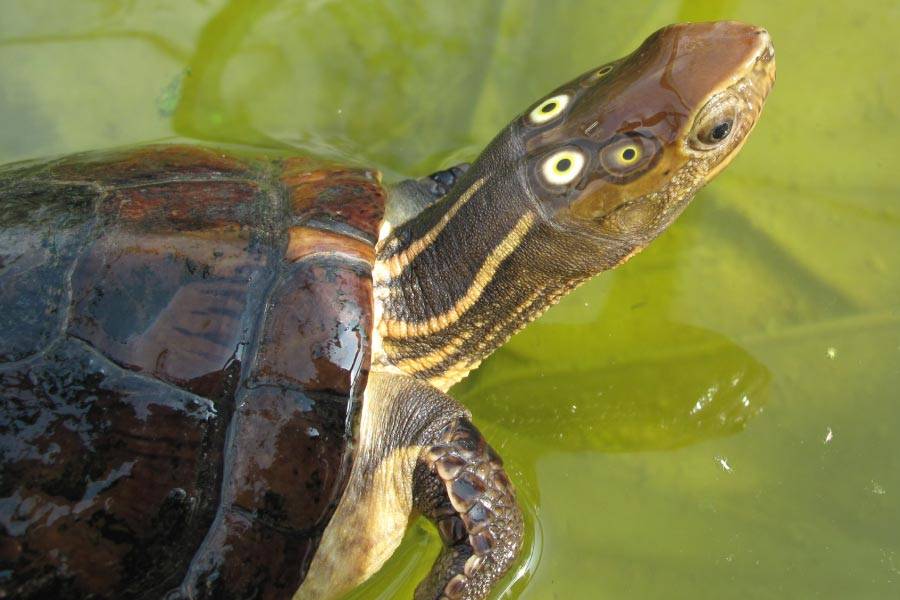
- Scientific name: Sacalia quadriocellata
- Suborder: Cryptodira (hidden-neck turtles)
- Family: Geoemydidae
- Where found: East and Southeast Asia
- Conservation status: Critically Endangered
The four-eyed turtle is one of the most striking species of turtle, having two – sometimes four – “fake” eye spots on the back of its head.
Four-eyed turtles of both sexes are 11 – 15 cm / 4.3 – 5.9 in. in length. Males have blue-green eye spots, while those of the female are yellow.
The species’ population is decreasing mainly due to their use in Asian food and medicine, as well as the capture of wild turtles for the pet trade. Habitat loss has also had an impact on the species.
This species has a yellow – tan carapace and is omnivorous. Although they are solitary, and only interact with each other during the breeding season, they don’t seem to mind sharing their space with other animals, including conspecifics.
Discover More with Active Wild
You can see more Asian animals on this page: Asian Animals: Pictures & Facts
Green Sea Turtle
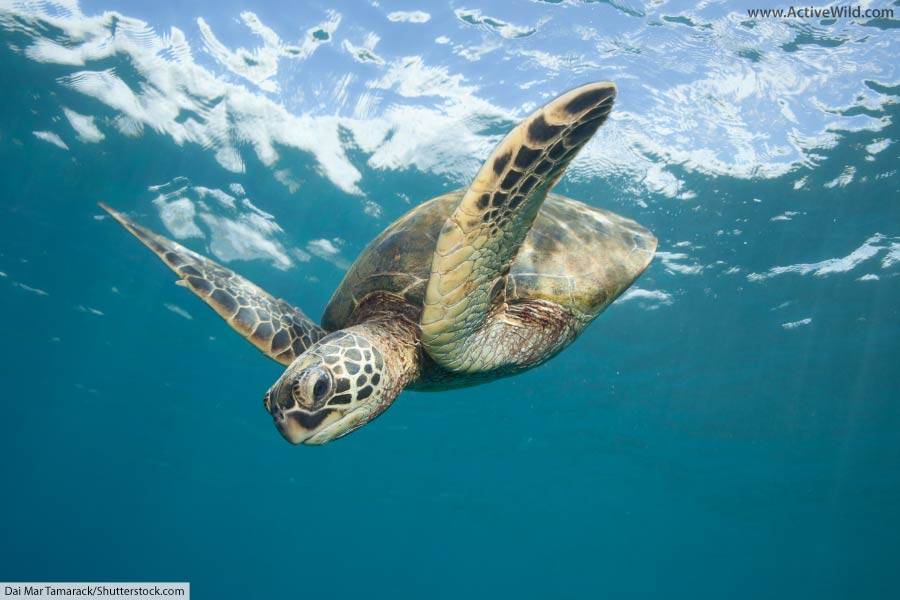
- Scientific name: Chelonia mydas
- Suborder: Cryptodira (hidden-neck turtles)
- Family: Cheloniidae
- Where found: Tropical and subtropical waters globally
- Conservation status: Endangered
reaching a weight of 200 kg / 440 lb., the green sea turtle is the largest hard-shelled sea turtle; only the leatherback sea turtle, which has a leathery carapace, is larger.
The green sea turtle gets its name, not because of its carapace color (which is a dark olive), but because of the green fat found under it.
It takes green sea turtles from 20 to 50 years to reach sexual maturity. Females return to the same beach on which they were born to lay their clutches. Very few hatchlings survive past their first year; according to several studies it is estimated that only 1 out of every 1000 make it to adulthood.
Green sea turtles are omnivores as juveniles, but after reaching a certain size their diet becomes almost entirely herbivorous.
This species is very social and usually moves in large groups that can swim as far as 90 km / 55.9 miles in a day.
Discover More with Active Wild
You can find out more about the green sea turtle on this page: Green Sea Turtle Facts
You can find out more about sea turtles on this page: Sea Turtle Facts
Hickatee
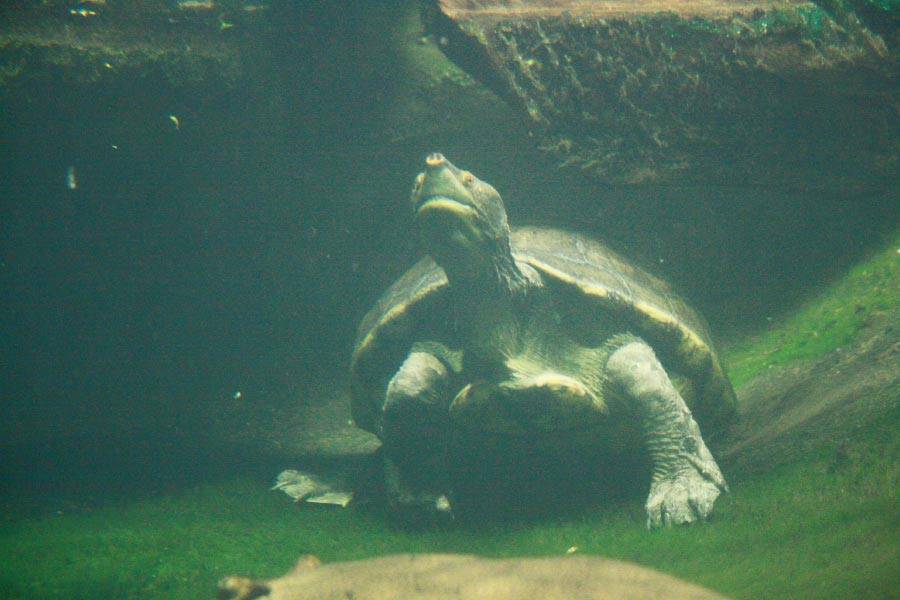
- Scientific name: Dermatemys mawii
- Suborder: Cryptodira (hidden-neck turtles)
- Family: Dermatemydidae
- Where found: Central America
- Conservation status: Critically Endangered
The Hickatee, also known as the central American river turtle, is found only in Atlantic-draining rivers and lakes from Southern Mexico, through Belize, to Guatemala. It mainly inhabits large, deep rivers and lakes, but will swim to other areas during the rainy season when water levels are higher.
The species is entirely aquatic, not even leaving the water to bask. It only emerges from the water to nest, and is a clumsy and slow walker. The hickatee is famously elusive, and humans struggle to locate its nests.
Unusually, the species’ eggs remain viable even after being underwater for weeks. This increases the chance of success for nests in flood-prone areas.
The Hickatee was culturally significant to ancient Mayan culture and was almost hunted to extinction during Mayan times.
The species’ situation is little improved today; still hunted for food, the hickatee is likely the most threatened turtle in its range. There is a strong possibility of its become extinct, despite Belize being the only country in which hunting the turtle is still legal.
Discover More with Active Wild
You can see more North American reptiles on this page: North American Reptiles List with Pictures & Facts
Leatherback Sea Turtle
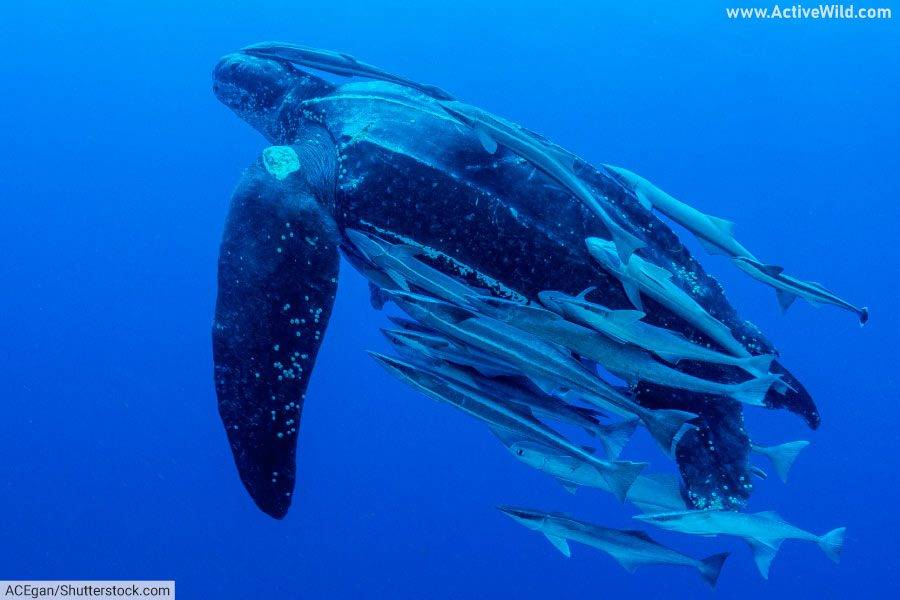
- Scientific name: Dermochelys coriacea
- Suborder: Cryptodira (hidden-neck turtles)
- Family: Dermochelyidae
- Where found: Globally
- Conservation status: Vulnerable
The leatherback sea turtle is the largest of all turtles, and the second-largest marine reptile, after the saltwater crocodile. The species can attain lengths of up to 1.8 m / 6 ft. and weights of over 450 kg / 1000 lb.
The leatherback sea turtle’s carapace lacks the hard, bony scutes found in the shells of hard-shelled turtles. Instead, the carapace has a tough but relatively soft, leathery texture, hence the species’ name. The leatherback is the only sea turtle to have such a shell.
The leatherback has a “cosmopolitan” global range, which extends across most of the world’s oceans, except Antarctica.
A migratory species, the leatherback sea turtle spends most of its time in open water, only coming ashore to lay eggs. (Male sea turtles never again set foot on land after hatching.)
The species feeds primarily on jellyfish and has an unusual adaptation to help it survive this diet: the turtle’s throat is lined with spines, which protect it from being stung.
The leatherback turtle is classified as vulnerable due to loss of habitat and hunting.
Discover More with Active Wild
You can find out more about the leatherback sea turtle on this page: Leatherback Sea Turtle Facts
You can find out more about sea turtles on this page: Sea Turtle Facts
Malaysian Giant Turtle
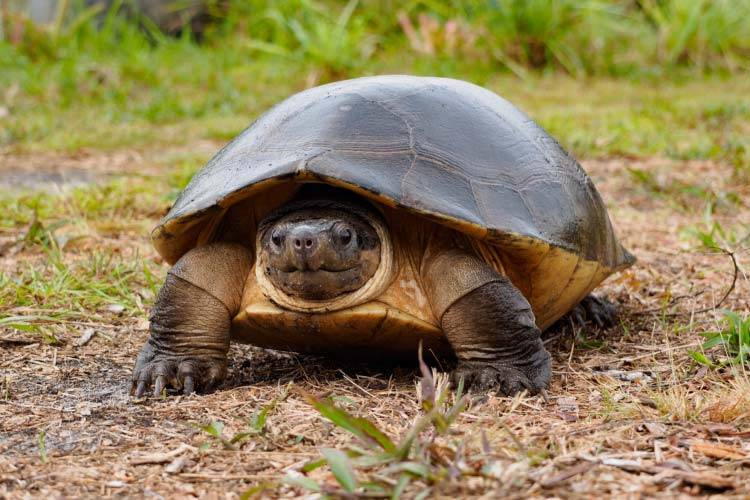
- Scientific name: Orlitia borneensis
- Suborder: Cryptodira (hidden-neck turtles)
- Family: Geoemydidae
- Where found: Indonesia and Malaysia
- Conservation status: Critically Endangered
With a carapace length of up to 80 cm / 2.62 ft. and a maximum weight of 50 kg / 110 lb., the Malaysian Giant Turtle is one of the largest turtle species in Southeast Asia. It is found in freshwater swamps, lakes and rivers in Peninsular Malaysia, and on the islands of Borneo and Sumatra.
This species primarily eats fish, but will also consume other small animals or fallen fruit.
The Malaysian Giant Turtle is critically endangered due to hunting and habitat loss. The species is hunted both for its meat and its shell, which is used in traditional Chinese medicine.
The palm oil industry is responsible for much of the habitat loss in Malaysia. As the demand for palm oil increases, more and more rainforest is being cleared to make way for plantations, Causing many animals to become endangered.
Discover More with Active Wild
You can see more Asian animals on this page: Asian Animals: Pictures & Facts
Painted Turtle
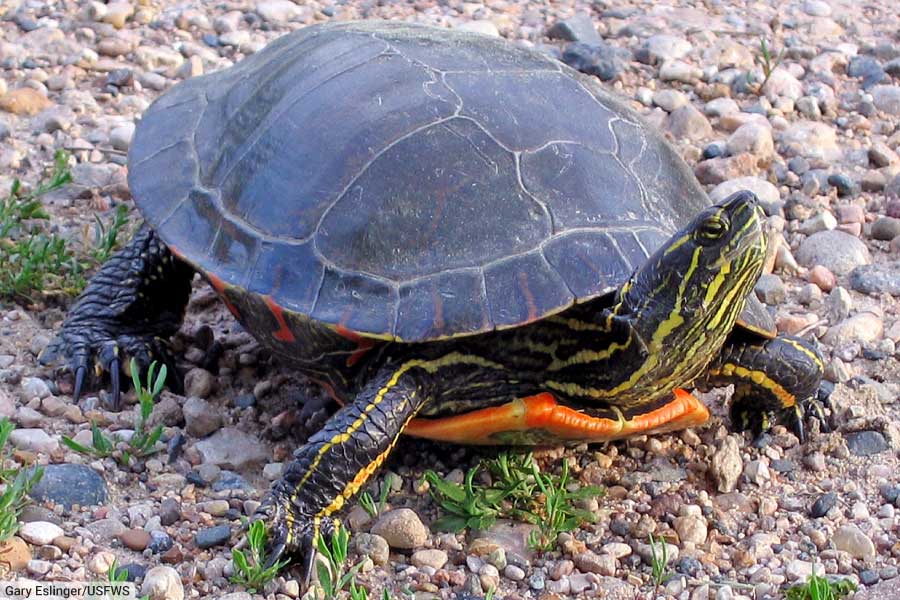
- Scientific name: Chrysemys picta
- Suborder: Cryptodira (hidden-neck turtles)
- Family: Emydidae
- Where found: North America
- Conservation status: Least Concern
The Painted Turtle is a common sight in ponds and lakes across North America. It is the most wide-ranging North American turtle, being found across the United States, as well as into southern Canada and northern Mexico.
The painted turtle is between 12 and 25 cm / 5 and 10 in. in length, with females being slightly larger than males. With bright yellow and red markings, it’s not hard to see how this turtle got its name.
Although mostly aquatic, the species will often pull itself out of the water to bask in the sun on logs or rocks. It is an omnivore, with both plant matter and small animals featuring in its diet.
During the winter months, the painted turtle buries itself in the mud at the bottom of a body of water and hibernates. This enables the species to inhabit regions that would otherwise be too cold for reptiles.
While buried in the mud, the painted turtle is unable to breathe, and the species is a much-studied example of a vertebrate that can survive for long periods without oxygen. (Source)
Discover More with Active Wild
You can see more North American reptiles on this page: North American Reptiles List with Pictures & Facts
Pig-Nosed Turtle
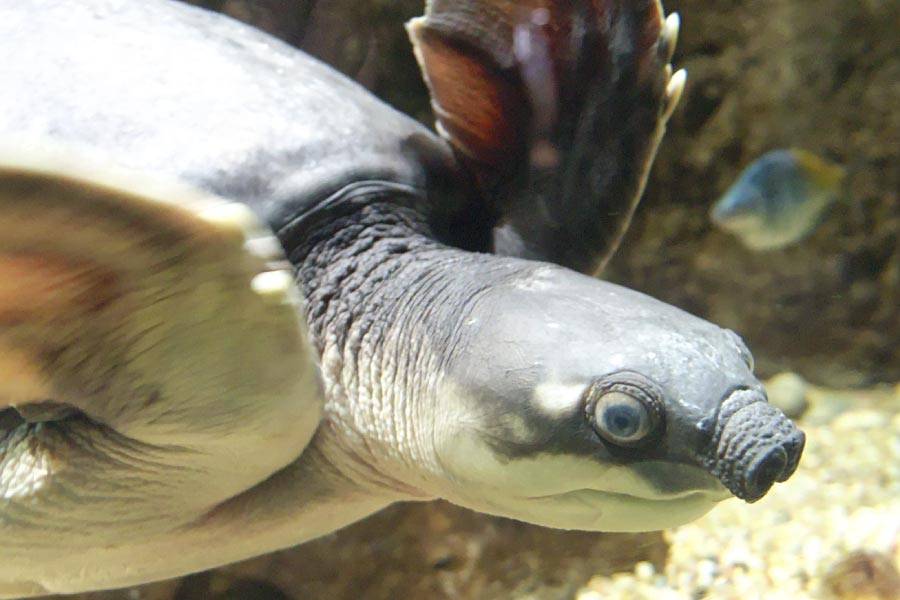
- Scientific name: Carettochelys insculpta
- Suborder: Cryptodira (hidden-neck turtles)
- Family: Carettochelyidae
- Where found: Northern Australia and southern New Guinea.
- Conservation status: Endangered
Found in the freshwater marshes and rivers of northern Australia, the pig-nosed turtle gets its name from its distinctive, pig-like snout, which is highly sensitive and helps the animal to forage for food.
The species is also notable for having flippers, rather than feet. In this respect it resembles sea turtles, rather than other freshwater turtles.
The pig-nosed turtle is part of the superfamily Trionychidae, also known as the soft-shell turtles. However, unlike others of this group, the pig-nosed turtle retains a bony carapace under its leathery skin instead of the usual flat plate.
Discover More with Active Wild
You can see more Australian reptiles on this page: Australian Reptiles List with Pictures & Facts
Pond Slider
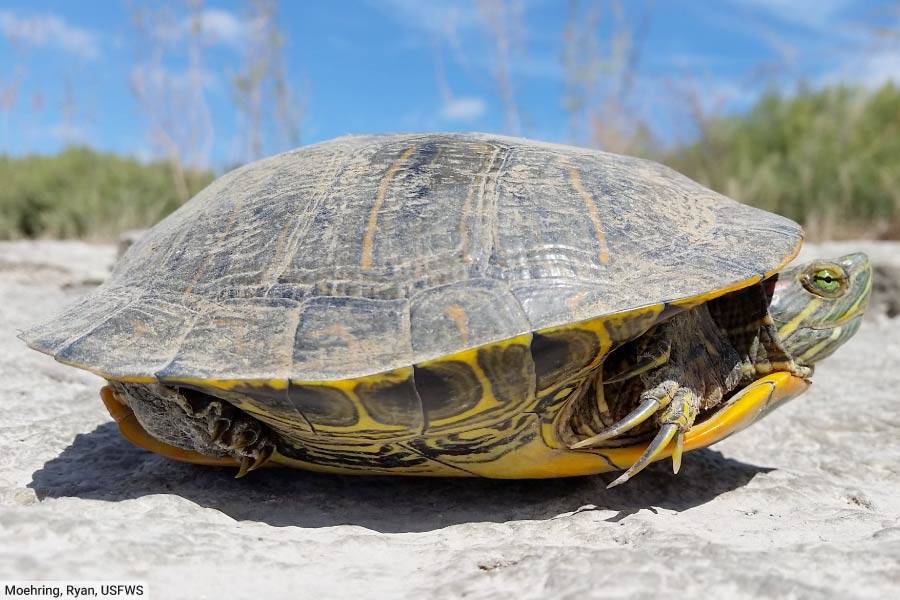
- Scientific name: Trachemys scripta
- Suborder: Cryptodira (hidden-neck turtles)
- Family: Emydidae
- Where found: South-central and southeastern United States and northern Mexico.
- Conservation status: Least Concern
The pond slider is a species of turtle native to the southern and southeastern United States and northern Mexico. It has three subspecies, the best-known of which is the red-eared slider. (The other two subspecies are the yellow-bellied and Cumberland sliders.)
The pond slider gets its name from its habit of sliding off rocks and logs into the water. The species is semi-aquatic, spending time both on land and in the water.
Due to its small size and docile nature, the pond slider is a popular pet turtle, both in its native North America and in many other parts of the world. Unfortunately, this has led to its becoming an invasive species outside of its native range. Released pets can be detrimental to ecosystems, posing a threat to native turtles and other species.
Discover More with Active Wild
You can see more North American reptiles on this page: North American Reptiles List with Pictures & Facts
Roti Island Snake-Necked Turtle
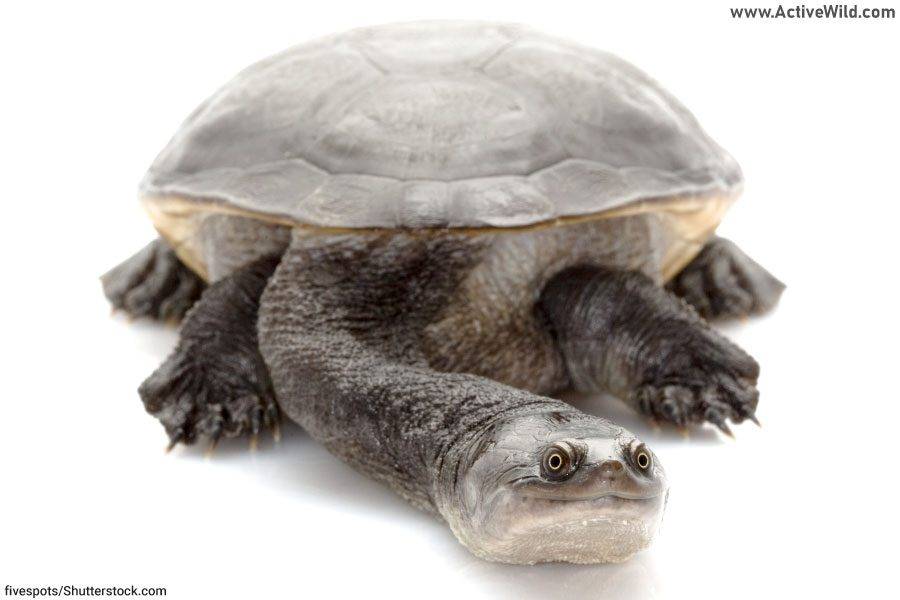
- Scientific name: Chelodina mccordi
- Suborder: Pleurodira (side-necked turtles)
- Family: Chelidae
- Where found: Southeast Asia
- Conservation status: Critically Endangered (possibly extinct in the wild)
The Roti Island snake-necked turtle was found on two Southeast Asian islands: Rote, which is part of Indonesia, and Timor. (The turtle is found on the East Timor part of the island).
Today, the critically endangered turtle may be extinct in the wild on Rote.
The Roti Island snake-necked turtle is known for its long neck, which can grow to almost as long as the carapace.
As a result of its unique appearance, the species is a popular target for poachers due to its high value in the illegal pet trade. This trade continues despite the species’ critically endangered status. (Source)
Captive breeding programs have been established in an attempt to save this species from extinction, but the future of the Roti Island Snake-Necked Turtle is far from certain.
Discover More with Active Wild
You can see more Asian animals on this page: Asian Animals: Pictures & Facts
You can see more ugly animals on this page: Ugly Animals Pictures & Facts
Spiny Softshell Turtle
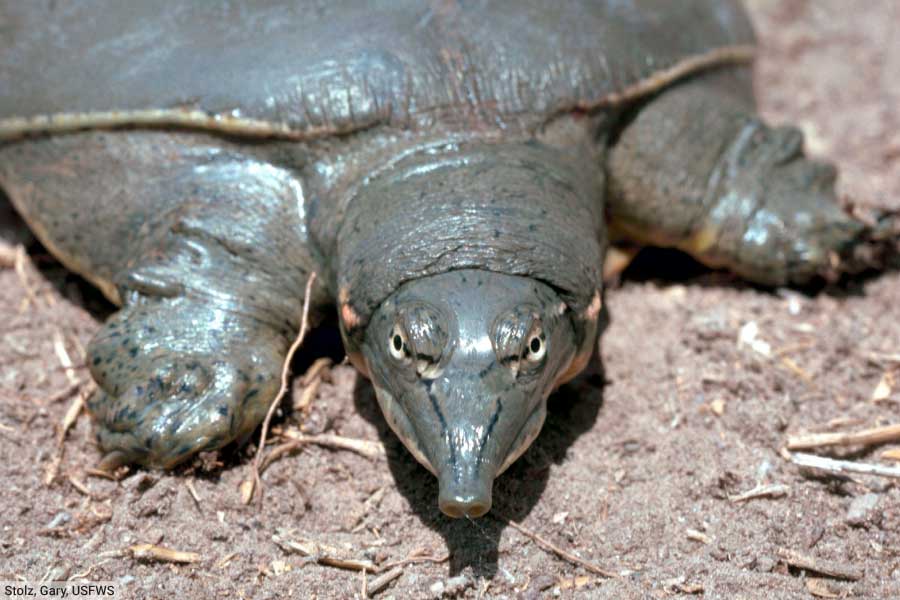
- Scientific name: Apalone spinifera
- Suborder: Cryptodira (hidden-neck turtles)
- Family: Trionychidae
- Where found: North America
- Conservation status: Least Concern
The spiny softshell turtle is a freshwater turtle found across North America. It is named for the short spines that protrude from the front edge of its shell, which has leathery, soft texture. Another distinguishing feature is the species’ long, “pig-like” nose.
With a maximum carapace length of around 54 cm / 21 in., the spiny softshell turtle is one of the continent’s largest freshwater turtles. Only females reach this size; males are somewhat smaller.
While most turtles are shy and reclusive, the Spiny Softshell Turtle is comparatively sociable and can often be seen basking communally in the sun.
The spiny softshell turtle is able to “breathe underwater” by absorbing oxygen and emitting carbon dioxide via its skin; no other freshwater turtle is as dependent on this method of breathing.
Discover More with Active Wild
You can see more North American reptiles on this page: North American Reptiles List with Pictures & Facts
Spotted Turtle
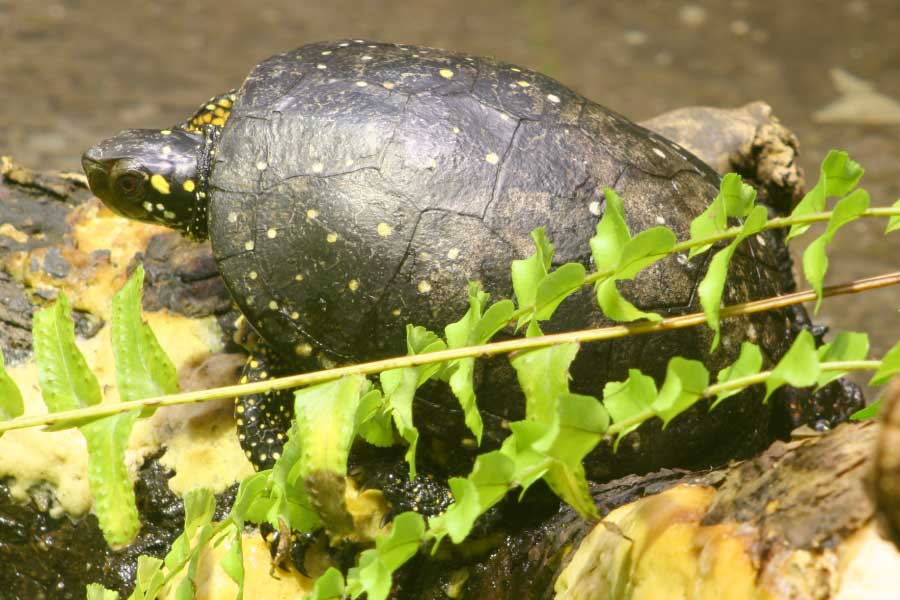
- Scientific name: Clemmys guttata
- Suborder: Cryptodira (hidden-neck turtles)
- Family: Emydidae
- Where found: North America
- Conservation status: Endangered
The Spotted Turtle is a small, semi-aquatic turtle found in ponds, marshes, and other wetlands throughout the eastern United States and Canada. Its carapace is black or dark brown with yellow spots, and between 9 and 13 cm / 3.5 and 5 inches in length.
A shy, reclusive species, the spotted turtle spends most of its time buried in mud at the bottom of ponds or streams. An omnivore, the spotted turtle feeds mainly on small aquatic animals, such as insect larvae and small fish, but will also eat plant material such as fruit and algae.
The spotted turtle is endangered due to a number of factors, including being taken from the wild to supply the pet trade, collisions with motor vehicles, and habitat loss.
Discover More with Active Wild
You can see more North American reptiles on this page: North American Reptiles List with Pictures & Facts
Striped Mud Turtle
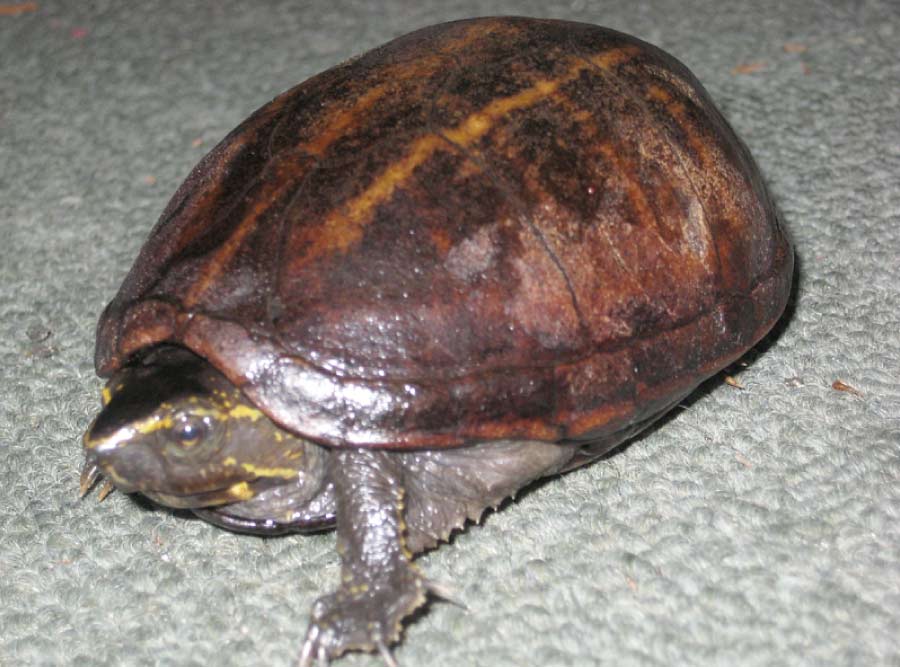
- Scientific name: Kinosternon baurii
- Suborder: Cryptodira (hidden-neck turtles)
- Family: Kinosternidae
- Where found: North America
- Conservation status: Least Concern
The Striped Mud Turtle is a small, stocky turtle with a dark brown or black shell marked with yellowish stripes. Like all turtles of family Kinosternidae (which includes mud and musk turtles), its carapace has a visible keel running along its center.
A common species, the striped mud turtle is found in still and slow-moving bodies of water across the southeastern United States. It is often encountered making foraging expeditions out of the water.
An omnivore, the Striped Mud Turtle preys on insects, snails, and small fish, and will also eat plants and algae.
the Striped Mud Turtle is an important member of its ecosystem, helping to control the population of its prey species.
Discover More with Active Wild
You can see more North American reptiles on this page: North American Reptiles List with Pictures & Facts
Western Box Turtle / Ornate Box Turtle
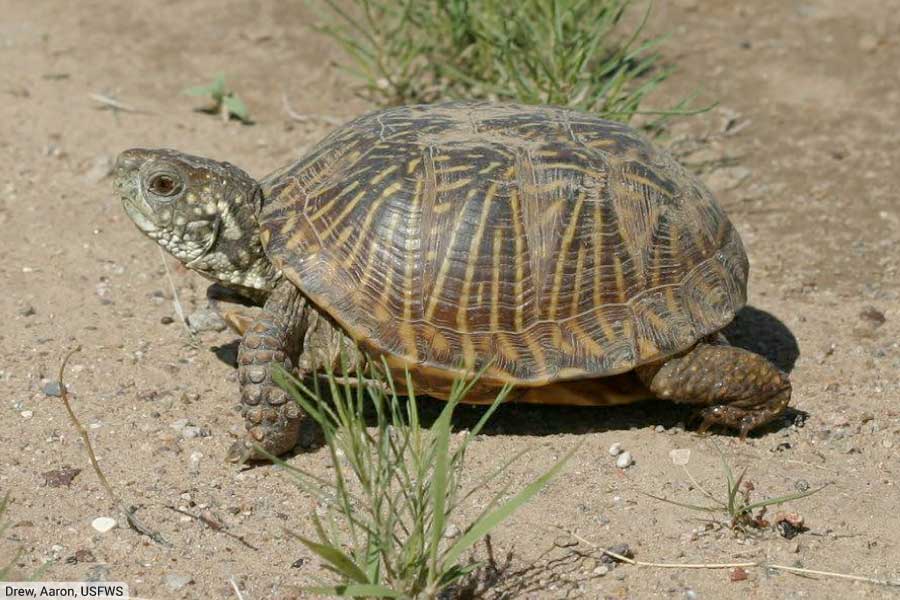
- Scientific name: Terrapene ornata
- Suborder: Cryptodira (hidden-neck turtles)
- Family: Emydidae
- Where found: Midwest and Southern United States, Gulf of Mexico
- Conservation status: Near Threatened
The western box turtle is one of six (or seven*) turtles of genus Terrapene, which together are known as “box turtles”.
* The Yucatán box turtle may or may not be a subspecies of the common box turtle.
Box turtles are terrestrial (land-dwelling) turtles that resemble tortoises. The western box turtle is found in a region roughly west of the Mississippi and east of the Rockies, and south into northern Mexico.
The species inhabits prairies, pastures and open woodlands and is often found far from a body of water.
Males and females can be distinguished by their coloring; males usually have red eyes and a red or orange patch on their throats, while females have brown eyes and no throat patch.
While the western box turtle is not currently endangered, its numbers are decreasing. This is largely due to habitat loss; the grasslands in which the turtle is found are increasingly being converted to farmland.
Additional threats to the western box turtle, which has a “Vulnerable” conservation status, include being injured, either by traffic or by farm machinery, and being removed from the wild to supply the pet trade.
The common box turtle has two subspecies: the ornate box turtle, which is found in the Great Plains region of the United States, and the desert box turtle, which is found in the southwestern United States and in Mexico.
Discover More with Active Wild
You can see more North American reptiles on this page: North American Reptiles List with Pictures & Facts
Western Swamp Turtle
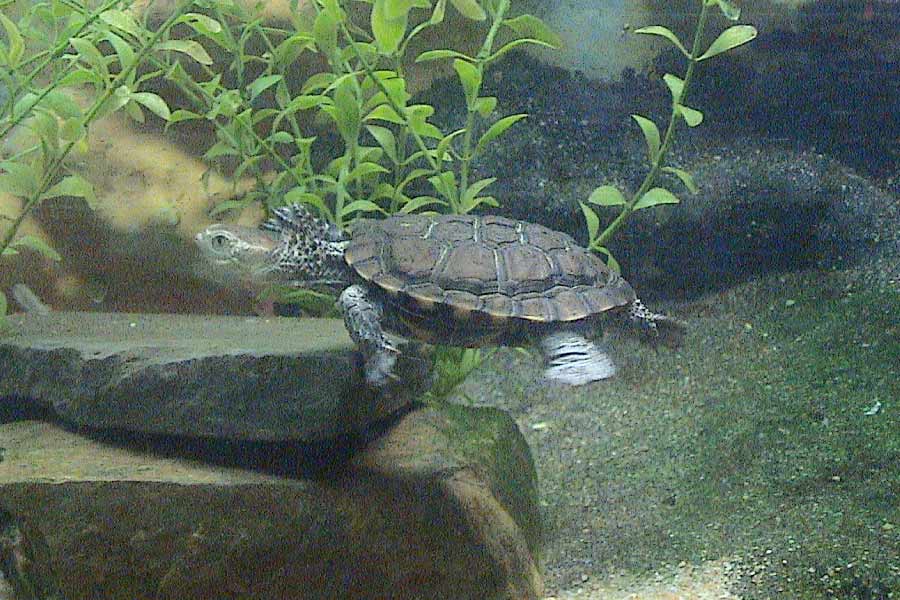
- Scientific name: Pseudemydura umbrina
- Suborder: Pleurodira (side-necked turtles)
- Family: Chelidae
- Where found: Western Australia
- Conservation status: Critically Endangered
The western swamp turtle is a critically endangered type of turtle turtle found in a limited number of fragmented locations around Perth in Western Australia. A relatively small species, its shell is typically no more than 15.5 cm / 6.1 inches in length. Males are slightly larger than females.
The Western Swamp Turtle has experienced a significant decline in numbers in recent years, and is Australia’s most endangered reptile. The main threat to the Turtle is habitat loss due to both agricultural and industrial development.
Conservation of this species is managed under a species recovery plan that includes population management, captive breeding at Perth Zoo, and preservation of nature reserves. The species also has a charity devoted to its conservation: the Friends of the Western Swamp Tortoise. (Source)
Discover More with Active Wild
You can see more Australian reptiles on this page: Australian Reptiles List with Pictures & Facts
Related Pages
- Reptiles: The Ultimate Guide
- Types Of Lizards
- Types Of Reptiles
- Is A Turtle A Reptile? And Why?
- Reptile Books
The post Types Of Turtles With Pictures, List Of Interesting Turtle Species appeared first on Active Wild.